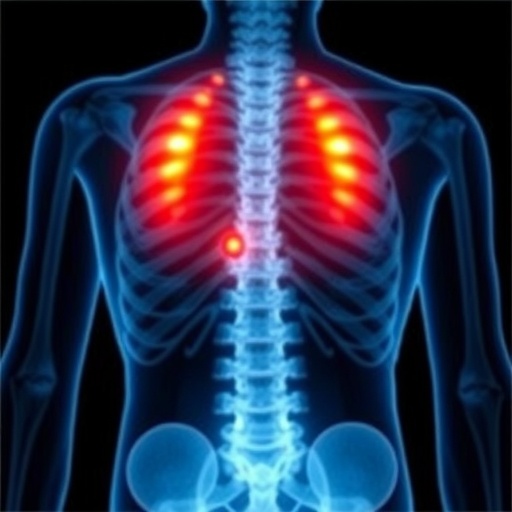In a groundbreaking advancement poised to transform the management of spinal disorders, a team of researchers led by Yamada, Hyakumachi, and Kokabu has developed an innovative acellular, bioresorbable, ultra-purified alginate gel designed for implantation in patients with intervertebral disc herniation. Published in Nature Communications, this study marks a pivotal turning point in regenerative medicine, addressing one of the most pervasive drivers of chronic pain and disability worldwide. The research unfolds through meticulously conducted Phase 1/2 clinical trials that detail the safety and initial efficacy of this biomaterial in human subjects, bringing renewed hope to millions suffering from degenerative disc diseases.
Alginate, a naturally occurring polysaccharide extracted primarily from brown seaweed, is widely recognized for its biocompatibility and gel-forming properties. However, traditional alginate materials frequently face challenges such as immune response activation and inconsistent purity levels that hinder clinical applicability. This study’s ultra-purification process involves advanced extraction and sterilization techniques that markedly reduce endotoxins and impurities, thereby minimizing inflammatory reactions post-implantation. The resulting gel exhibits exceptional biocompatibility, biodegradability, and mechanical properties tailored to mimic native disc tissue environments.
The bioresorbable nature of this alginate gel is another critical innovation. Unlike synthetic biomaterials that often persist and induce chronic foreign body responses, the gel is designed to degrade strategically over time, providing a temporary scaffold supporting tissue healing. This degradation profile aligns with the biological timelines of intervertebral disc repair, allowing for seamless transition as native extracellular matrix components progressively replace the implanted material. The biomaterial’s acellular design further mitigates immune rejection risks, optimizing patient safety.
The clinical trials detailed herein employed a non-randomized, open-label format, enrolling patients with symptomatic lumbar disc herniations eligible for minimally invasive intervention. Participants received percutaneous injections of the ultra-purified alginate gel into the affected discs under fluoroscopic guidance, closely monitored for both clinical outcomes and potential adverse events. This strategic approach ensured real-world applicability, capturing the nuances of patient responses while maintaining rigorous safety standards.
Initial findings from the trial demonstrated promising safety profiles with minimal adverse reactions. Most notably, patients exhibited significant reductions in pain scores and functional disability metrics within weeks of implantation. Imaging studies corroborated these clinical improvements, revealing stabilization or partial restoration of disc height and morphology in treated segments. These results confirm the gel’s role not merely as a filler but as an active participant in the disc repair microenvironment.
Mechanistically, the ultra-purified alginate gel fosters a conducive milieu for endogenous cell migration and extracellular matrix synthesis. By recapitulating the biochemical and mechanical cues of native disc tissue, it stimulates resident progenitor cells and inhibits catabolic processes commonly associated with disc degeneration. The gel’s porous architecture enables nutrient diffusion and waste removal, addressing one of the intrinsic challenges in intervertebral disc biology attributed to its avascularity.
Further biochemical analyses clarified that the alginate gel modulates inflammatory cascades by downregulating pro-inflammatory cytokines and upregulating anti-inflammatory mediators within the disc space. This immunomodulatory capacity substantially contributes to pain relief and functional recovery, emphasizing the gel’s multifaceted therapeutic potential beyond simple structural support.
One of the study’s distinguishing features lies in the procedural simplicity coupled with precision. Injection of the gel through minimally invasive techniques reduces surgical trauma and hospital stay durations, highlighting the intervention’s suitability for outpatient settings. Additionally, the formulation’s rheological properties enable controlled gelation kinetics, ensuring optimal conformability within the irregular disc clefts, thereby uniformly distributing biomechanical loads and preventing implant migration.
Despite the promising outcomes, the authors prudently recognize the necessity for extended follow-up studies to validate long-term efficacy and durability of clinical benefit. Future randomized controlled trials with larger cohorts are warranted to establish statistical robustness and investigate comparative effectiveness against current gold-standard treatments such as microdiscectomy or total disc replacement.
The broader implications of this research transcend intervertebral disc pathology, positioning the ultra-purified alginate gel platform as a versatile scaffold for diverse musculoskeletal regenerative applications. Ongoing investigations aim to tailor the gel’s composition for cartilage, tendon, and even neural tissue engineering, leveraging its biocompatibility and tunable degradation for a spectrum of clinical challenges.
In conclusion, the ultra-purified alginate gel implantation investigated by Yamada and colleagues emerges as a pioneering approach that harmonizes biological compatibility, mechanical functionality, and procedural feasibility. The Phase 1/2 trial outcomes herald a new era in spinal regeneration — one rooted in harnessing the body’s inherent repair mechanisms augmented by sophisticated biomaterials. As further research unfolds, this technology could redefine standards of care, offering patients a minimally invasive, bioresorbable solution that addresses both symptoms and underlying pathology with unprecedented efficacy.
Subject of Research: Regenerative biomaterial implantation for the treatment of intervertebral disc herniation.
Article Title: Acellular, bioresorbable, ultra-purified alginate gel implantation for intervertebral disc herniation: Phase 1/2, open-label, non-randomized clinical trials.
Article References:
Yamada, K., Hyakumachi, T., Kokabu, T. et al. Acellular, bioresorbable, ultra-purified alginate gel implantation for intervertebral disc herniation: Phase 1/2, open-label, non-randomized clinical trials. Nat Commun 16, 4285 (2025). https://doi.org/10.1038/s41467-025-59715-0
Image Credits: AI Generated
Tags: acellular biomaterials for spinal disordersalginate polysaccharide applicationsbioresorbable scaffold technologychronic pain management solutionsdegenerative disc disease therapiesintervertebral disc herniation treatmentnerve root compression reliefnon-invasive spinal treatment optionsPhase 1/2 clinical trialsregenerative medicine innovationstissue repair and regeneration methodsultra-purified alginate gel





